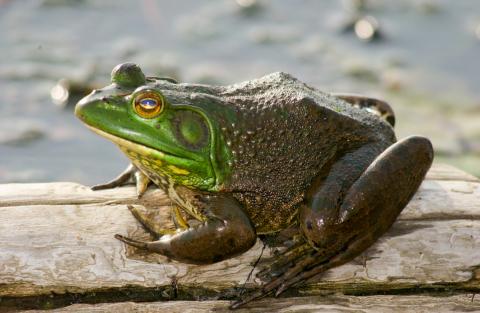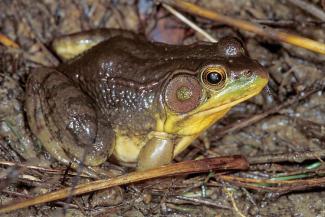About Frogs
Bullfrogs and green frogs look similar but are easy to tell apart from other frogs in Missouri, due to their relatively large size at maturity. They prefer aquatic edge habitats that offer still, shallow water with aquatic and/or terrestrial vegetation. This provides both cover and food, such as insects and nearly any other small animal that will fit in their mouths. Ponds, lakes and river banks, wetlands, and other vegetated waterways are all great places to find frogs.
Frog Hunting
Methods
Frogs can be hunted in Missouri using many different methods.
With a fishing permit, frogs may be taken by gig, trotline, throw line, limb line, bank line, jug line, snagging, snaring, grabbing, or pole and line.
With a hunting permit, frogs may be taken by crossbow, pellet gun, or .22 or smaller caliber rim-fire rifle or pistol.
With either permit frogs may be taken by hand, hand net, bow, or atlatl.
When to Hunt Frogs
- Frogs may be pursued during the day or at night with an artificial light.
- During a full moon frogs are typically more skittish because they feel more exposed, and are thus more difficult to approach.
- During a new moon it is usually easier to get closer to them.
Because frogs are amphibious and must keep their skin moist, they spend more time in the water and weeds during the day and are generally less visible around the banks than at night. Whether they’re hiding or not, their location is often given away by their assertive croaks.
Getting Started
Frog-Hunting Gear
- Rubber knee boots or hip waders
- Flashlight
- Gig or net
- Something to keep your harvested frogs in
Choosing a Location
Public and private landowners typically do not manage for frogs. Instead, frog populations are often the result of management for another species such as waterfowl or fish. Frogs are also common in aquatic edge habitats not subject to management or maintenance of any kind.
Waters with few to no predators will yield the best frog populations, which is why newer ponds or very old ponds are generally plentiful with frogs. Bullfrogs and green frogs can be found along nearly all waterways on MDC conservation areas but especially on wetland areas and along rivers and lakes.
Bullfrogs are ambush-style predators that will eat any live prey they can fit in their mouths, including insects, fish, mice, birds, and snakes! Focus on shallow water areas and mud flats along the margins of ponds, lakes and wetlands where cattails, willows, grasses, and other aquatic vegetation is present.
Tips and Tricks
- If you are hunting with a partner, have them blind the frog using a light so that you can stalk the frog from behind. Frogs can feel the vibrations of you approaching on foot, sometimes causing them to flee before you locate them.
- Consider using a canoe to stealthily locate and get close enough to grab, net, or gig.
Try Hunting During the Day
Most frogs are caught with the use of a gig or by bare hands at night. For a little different experience, try fishing during the day. Simply use a long fishing pole, like a cane poll or crappie rod, with a short piece of fishing line and a small treble hook tied to the end. Attach a small piece of red cloth to the hook and dangle in front of the frog. Often temptation will get the best of the frog and it will strike at the cloth. The only thing left to do is set the hook.























